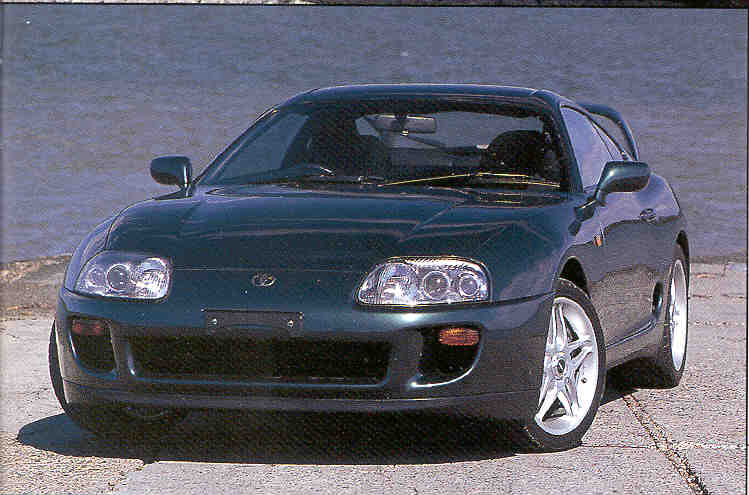| High Performance Imports |
| Class of 95 |
This is a 1995 model Toyota Supra RZ. As you probably know by now, RZ means it is the
twin-turbo model, but not the luxury version (GZ). The most significant thing, however, is
that this is a 1995 model.
During 1995 Toyota released the second series of the Supra body shape. Like any other face-lift
it came with different-style wheels and a number of detail improvements. In terms of body-shape
there are no obvious changes, but one very important change lurks just behind the wheels. There
you'll find some of the best brakes ever fitted to a production car.
Whereas the 93/94 Supra had good brakes, these are sensational. The front discs are visibly
bigger, with an enormous four-piston calliper bearing the Supra logo. At the rear, the discs
appear to be the usual size as before, but now they feature dual-piston callipers, also with a
Supra logo. The rotors are vented front and rear, but not drilled or slotted. Of course on top
of this you get an ABS system, which works particularly well.
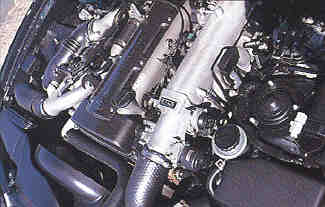
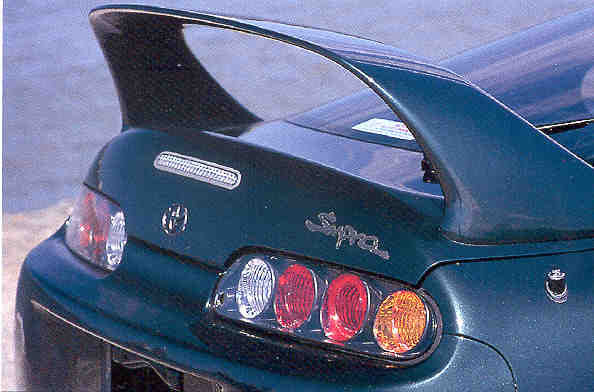 It may seem strange to go on about brakes like this, but when you remember the weight of this
car just over 1500kg) the way it pulls up is just amazing - better than the R32 GT-R tested
last issue. Repeated hard stops from l00km/h showed no fade whatsoever. While there are other
advantages to buying this model over the '93/'94 model (including the simple fact it is newer),
for me the greatest attraction is the stoppers.
As you will no doubt have noticed by now, this example is also an automatic. Having sampled the
older RZ in manual, I was interested to see how well the automatic gearbox would work with the
twin sequential turbos of the 2JZ-GTE engine. It does seem a shame to forego the novelty of the
6-speed manual gearbox for a normal 4-speed auto, but I must admit that this box works very well.
Kick-down is quite rapid and if your foot is hard against the firewall it will hold gears right
to the redline.
It may seem strange to go on about brakes like this, but when you remember the weight of this
car just over 1500kg) the way it pulls up is just amazing - better than the R32 GT-R tested
last issue. Repeated hard stops from l00km/h showed no fade whatsoever. While there are other
advantages to buying this model over the '93/'94 model (including the simple fact it is newer),
for me the greatest attraction is the stoppers.
As you will no doubt have noticed by now, this example is also an automatic. Having sampled the
older RZ in manual, I was interested to see how well the automatic gearbox would work with the
twin sequential turbos of the 2JZ-GTE engine. It does seem a shame to forego the novelty of the
6-speed manual gearbox for a normal 4-speed auto, but I must admit that this box works very well.
Kick-down is quite rapid and if your foot is hard against the firewall it will hold gears right
to the redline.
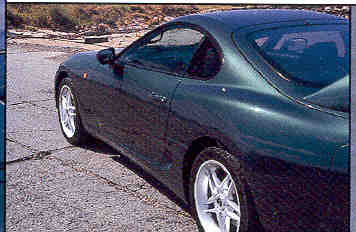
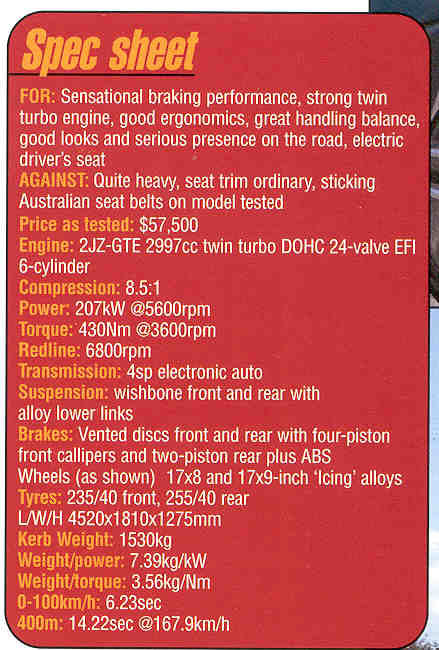 Thanks to the tall overall gearing and relatively broad power spread, for most twisty roads
you can simply leave the shifter in second gear. Cruising in fourth at l00km/h the engine is
ticking over at just 2200rpm, which is the same gearing as sixth in the manual. In fact third
gear will take you to the 180km/h speed limiter at around 6000rpm (the redline is 6800).
The sequential setup of the twin turbos is especially useful with the automatic, as the smaller
turbo spools up at low revs and prevents the lethargic feel that some turbo automatics have
below 3000rpm. It doesn't exactly feel like you're getting turbo boost, but it does feel more
responsive. The larger turbo doesn't really kick in until just before 4000rpm, but then the car
really pulls hard.
Once you spend some time driving a Supra it's very easy to like them. Cruising around at
normal speeds they are well behaved and have quite a reasonable ride, yet wind them up and
they feel like the high-velocity Grand Tourer that they are. Driven hard the Supra responds
as a rear-wheel- drive sports car should. Turning into a corner reveals very precise steering
with quite quick gearing. The weighting is ideal and the power steering robs only a small
degree of feel. As the car turns in so sharply, it can feel a little floaty as it settles
into its line around the apex, but once you've started getting back on the throttle it holds
the line perfectly and you can really put some power down on the exit. Push it and the inside
wheel will start to lose traction, giving you progressive and controllable oversteer, which is
quite fun for adventurous drivers. For those who prefer less spectacular cornering, the
traction control system does help keep the tail in line.
Thanks to the tall overall gearing and relatively broad power spread, for most twisty roads
you can simply leave the shifter in second gear. Cruising in fourth at l00km/h the engine is
ticking over at just 2200rpm, which is the same gearing as sixth in the manual. In fact third
gear will take you to the 180km/h speed limiter at around 6000rpm (the redline is 6800).
The sequential setup of the twin turbos is especially useful with the automatic, as the smaller
turbo spools up at low revs and prevents the lethargic feel that some turbo automatics have
below 3000rpm. It doesn't exactly feel like you're getting turbo boost, but it does feel more
responsive. The larger turbo doesn't really kick in until just before 4000rpm, but then the car
really pulls hard.
Once you spend some time driving a Supra it's very easy to like them. Cruising around at
normal speeds they are well behaved and have quite a reasonable ride, yet wind them up and
they feel like the high-velocity Grand Tourer that they are. Driven hard the Supra responds
as a rear-wheel- drive sports car should. Turning into a corner reveals very precise steering
with quite quick gearing. The weighting is ideal and the power steering robs only a small
degree of feel. As the car turns in so sharply, it can feel a little floaty as it settles
into its line around the apex, but once you've started getting back on the throttle it holds
the line perfectly and you can really put some power down on the exit. Push it and the inside
wheel will start to lose traction, giving you progressive and controllable oversteer, which is
quite fun for adventurous drivers. For those who prefer less spectacular cornering, the
traction control system does help keep the tail in line.
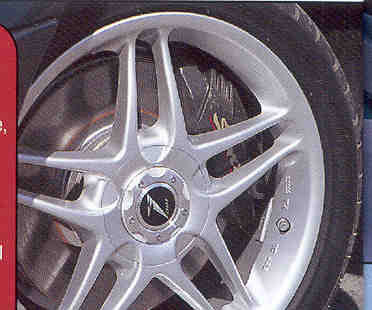
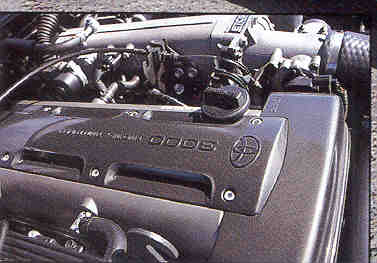 The switchable traction control system or 'slip control' as Toyota call it, works by using the
usual ABS sensors and operating a second throttle butterfly to reduce power until the rear
wheels regain traction. Look at the inlet manifold and you can see that there are two throttle
bodies in series, one with a cable and one with a solenoid which stays fully open until needed.
For performance testing we found that the slip control did help the car get away more cleanly.
Without it the best run was 0-l00km/h in 6.36 seconds and 400m in 14.37 seconds. With the slip
control turned on this dropped to 6.23 1-100kmh and 14.22 with a high terminal speed of
167.9km/h. I've really come to like the engines in imported Toyotas, as they are so eager to
rev and feel so great when you wind them out to the redline. It's sad that local offerings don't
offer this kind of excitement.
The build quality of the Supra is also excellent. Looking in the engine bay you'll spot the
impressive cast alloy crossmember. Likewise many of the suspension components are cast and the
engine mounts are expensive hydraulic units, which help make the 2JZ seem even smoother. The
general fit and finish of the panels and the quality of the paint is also about as good as
you'll find anywhere.
My one gripe, as usual, is the odd trimmiing used on the seats. The front buckets have a
nylon-like woven material, while the rear 'plus two' is trimmed in cheap black vinyl. It
seems like an odd cost-saving measure compared to the other parts I just mentioned.
Something specific to this car that irritated me was the seat belts. Naturally being a low
volume import these had already been swapped to Australian items, which clearly don't work as
well as the originals. Presumably because of the mounting angle, the retractable reel would
almost invariably lock when pulling on the belt, which really starts to drive you mad after
the tenth time. Make sure you check the operation of the belts if you are test driving a Supra
yourself, to make sure the correct inertia reel design has been used.
The switchable traction control system or 'slip control' as Toyota call it, works by using the
usual ABS sensors and operating a second throttle butterfly to reduce power until the rear
wheels regain traction. Look at the inlet manifold and you can see that there are two throttle
bodies in series, one with a cable and one with a solenoid which stays fully open until needed.
For performance testing we found that the slip control did help the car get away more cleanly.
Without it the best run was 0-l00km/h in 6.36 seconds and 400m in 14.37 seconds. With the slip
control turned on this dropped to 6.23 1-100kmh and 14.22 with a high terminal speed of
167.9km/h. I've really come to like the engines in imported Toyotas, as they are so eager to
rev and feel so great when you wind them out to the redline. It's sad that local offerings don't
offer this kind of excitement.
The build quality of the Supra is also excellent. Looking in the engine bay you'll spot the
impressive cast alloy crossmember. Likewise many of the suspension components are cast and the
engine mounts are expensive hydraulic units, which help make the 2JZ seem even smoother. The
general fit and finish of the panels and the quality of the paint is also about as good as
you'll find anywhere.
My one gripe, as usual, is the odd trimmiing used on the seats. The front buckets have a
nylon-like woven material, while the rear 'plus two' is trimmed in cheap black vinyl. It
seems like an odd cost-saving measure compared to the other parts I just mentioned.
Something specific to this car that irritated me was the seat belts. Naturally being a low
volume import these had already been swapped to Australian items, which clearly don't work as
well as the originals. Presumably because of the mounting angle, the retractable reel would
almost invariably lock when pulling on the belt, which really starts to drive you mad after
the tenth time. Make sure you check the operation of the belts if you are test driving a Supra
yourself, to make sure the correct inertia reel design has been used.
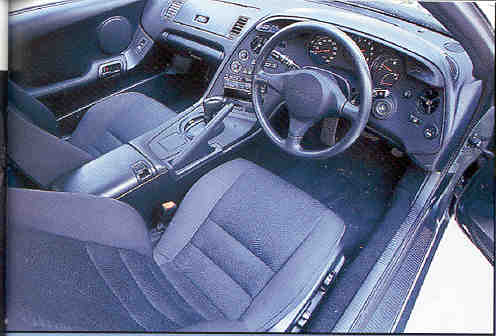
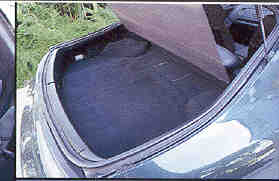 This gripe aside, the general ergonomics of the cabin are very good. While it doesn't feel
very roomy for such a large car, everything is very well placed for reach and visibility.
The driving position is especially good, even though the steering wheel is only adjustable
for rake, because there is ample legroom and the seat is height-adjustable. The driver's
seat actually has electric controls on the side for fore-aft, height and reclining. Head-room
is quite okay too, at least in the front. The rear seats are very cramped, as you would expect
in a car this shape.
The steering wheel and ergonomically-shaped shifter are both leather-bound, but this example
had no airbags. The usual gamut of electric gadgets includes digital climate control air
conditioning, power windows and mirrors, but again no cruise control. For some reason few
Japanese cars have this feature, which is a pity, because this car would be ideal for long
inter-city trips.
This gripe aside, the general ergonomics of the cabin are very good. While it doesn't feel
very roomy for such a large car, everything is very well placed for reach and visibility.
The driving position is especially good, even though the steering wheel is only adjustable
for rake, because there is ample legroom and the seat is height-adjustable. The driver's
seat actually has electric controls on the side for fore-aft, height and reclining. Head-room
is quite okay too, at least in the front. The rear seats are very cramped, as you would expect
in a car this shape.
The steering wheel and ergonomically-shaped shifter are both leather-bound, but this example
had no airbags. The usual gamut of electric gadgets includes digital climate control air
conditioning, power windows and mirrors, but again no cruise control. For some reason few
Japanese cars have this feature, which is a pity, because this car would be ideal for long
inter-city trips.
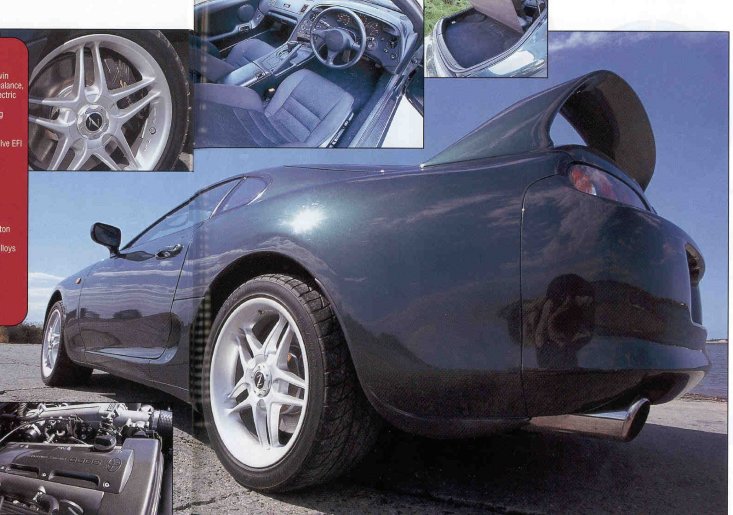 Cruising in fourth at low revs it should prove quite economical, yet you've always got the
power there for rocketing past that errant caravan. The ride is smooth enough to be pleasant
yet firm enough to be fun, while the driving position and climate control ensure comfort on a
long trip. If you do a lot of kilometres and like to travel in style, the automatic RZ is a
fine way to do it.
Special thanks go to Advance Auto Imports for supplying this test car. Phone Advance on
(07) 3862 2514 for more information on this and other models.
Cruising in fourth at low revs it should prove quite economical, yet you've always got the
power there for rocketing past that errant caravan. The ride is smooth enough to be pleasant
yet firm enough to be fun, while the driving position and climate control ensure comfort on a
long trip. If you do a lot of kilometres and like to travel in style, the automatic RZ is a
fine way to do it.
Special thanks go to Advance Auto Imports for supplying this test car. Phone Advance on
(07) 3862 2514 for more information on this and other models.
|
